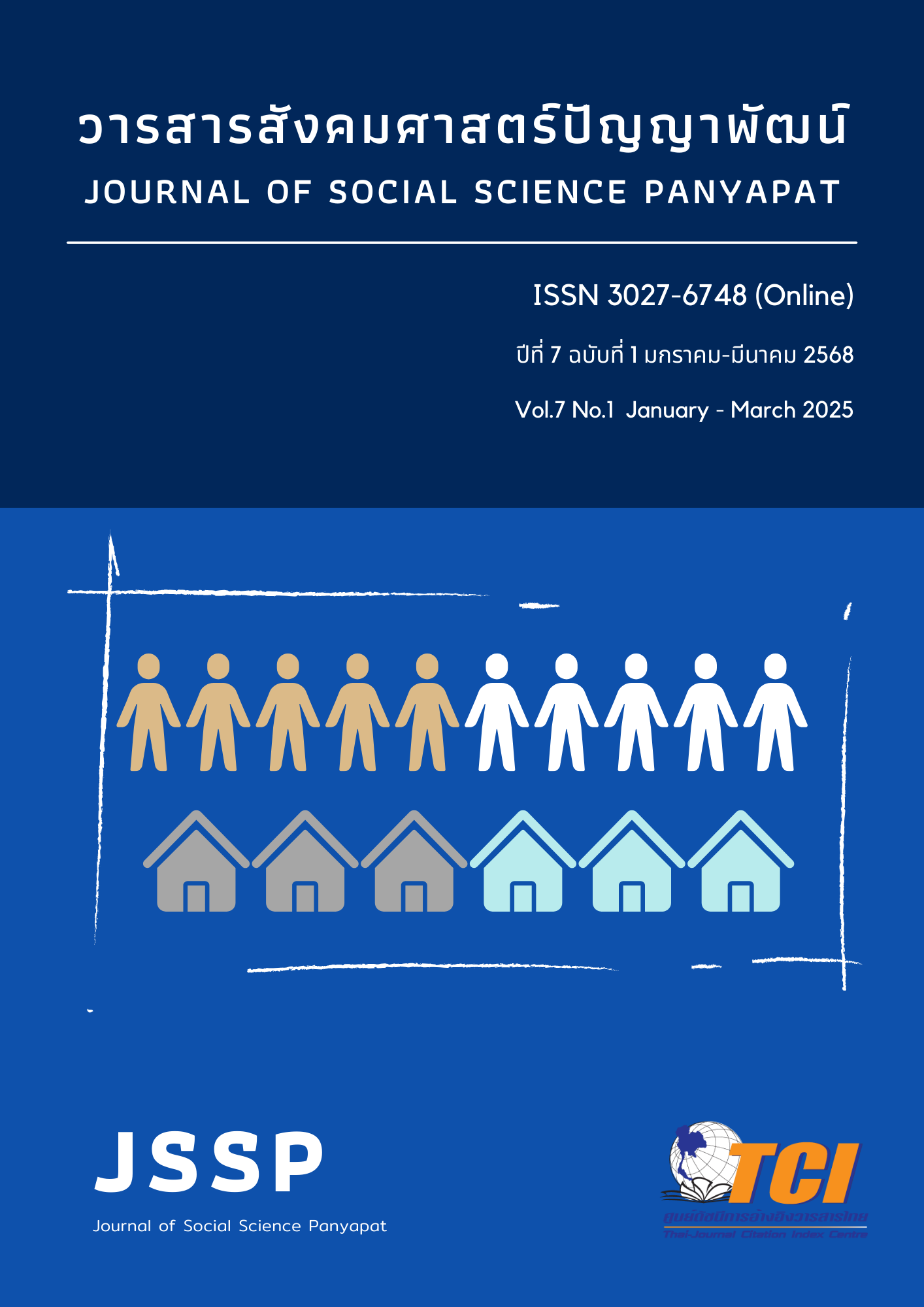Factors Influencing Digital Asset Market
คำสำคัญ:
Bitcoin, Cryptocurrency, Digital Assets, Granger Causality, PESTELบทคัดย่อ
Research on the factors influencing the digital asset market mainly comprises two objectives: 1) to examine factors that determine the digital asset market by focusing on six dimensions such as politics, economy, society, technology, environment, and law, 2) to study the relationship between economic variables and the value of the digital asset market. This study applies both qualitative and quantitative analysis. Qualitative analysis using the PESTEL model is used to study factors determining the digital asset market, while quantitative analysis using the Granger Causality test is employed to examine the relationship between economic factors and digital asset market value. This study covers the period from 2017 to 2022. The results suggest that political, economic, social, technological, environmental, and law factors are related to the acceptance of cryptocurrencies. Furthermore, some macroeconomic variables, such as average world headline CPI and world food price have a significant effect on digital asset market capitalization and the market capitalization of Bitcoin. In addition, the market capitalization of major digital assets and Bitcoin also significantly impact the stock markets, particularly on the Dow Jones Industrial Average, S&P 500, and Nasdaq. Therefore, policymakers can mitigate potential contagion risk by implementing robust monitoring and surveillance mechanisms.
เอกสารอ้างอิง
Alvarez, F., Argente, D., & Van Patten, D. (2023). Are cryptocurrencies currencies? Bitcoin as legal tender in El Salvador. Science, 382(6677), eadd2844.
Baur, D. G., Hong, K., & Lee, A. D. (2018). Bitcoin: Medium of exchange or speculative assets?. Journal of International Financial Markets, Institutions and Money, 54, 177-189.
BBC. (2020). PayPal allows Bitcoin and crypto spending. Retrieved from https://www.bbc.com/news/technology-54630283.
BBC. (2021). Guide: What is Bitcoin and how does it work?. Retrieved from https://www.bbc.co.uk/newround/25622442.
Binance. (2021). Global Crypto User Index. Binance Report. Retrieved from https://research.binance.com/static/pdf/Global_Crypto_Index_2021.pdf.
Blockchain Magazine. (2022). Bitcoin, Ethereum, and Dogecoin are the three most popular crypto assets in 2022. Retrieved from https://blockchainmagazine.com.
Burke, L. (2014). Due Diligence: Digital Currency. Retrieved from https://www.ifcreview.com/articles/2014/april/due-diligence-digital-currency/.
Cheng, E. (2018). Bad news for bitcoin miners: it‘s no longer profitable to create the cryptocurrency, by some estimates. Retrieved from https://www.cnbc.com.
CNBC. (2022). Bitcoin production roars back in China despite Beijing’s ban on crypto mining. Retrieved from https://www.cnbc.com/2022/05/18/china-is-second-biggest-bitcoin-mining-hub-as-miners-go-underground.html.
Coinmarketcap. (2022). Cryptocurrency Prices, Charts and Market Capitalizations. Retrieved from https://coinmarketcap.com/.
Cong, L. W., Ghosh, P., Li, J., & Ruan, Q. (2024). Inflation expectation and cryptocurrency investment (No. w32945). Cambridge: National Bureau of Economic Research.
Digiconomist. (2022). Bitcoin Energy Consumption Index. Retrieved from https://digiconomist.net/bitcoin-energy-consumption/.
Dyhrberg, A. H. (2016). Hedging capabilities of bitcoin. Is it the virtual gold?. Finance Research Letters, 16, 139-144.
Flynn, J. (2022). How many businesses accept Bitcoin?: 21 important Bitcoin Statistics. Retrieved from https://www.zippia.com/advice/how-many-businesses-accept-bitcoin/
Kajchamaporn, V. (2021). Money Laundering by Cryptocurrency Transaction. Journal of Business Administration and Social Sciences Ramkhamhaeng University, 4(2), 1-18.
Karau, S. (2023). Monetary policy and Bitcoin. Journal of International Money and Finance, 137, 102880.
Lisa, A. (2022). 14 Major Companies that accept Bitcoin. Retrieved from https://www.gobankingrates.com/money/business/major-companies-that-accept-bitcoin/.
Marketsandmarket. (2021). Blockchain Supply chain market. Retrieved from https://www.marketsandmarkets.com/Market-Reports/blockchain-supply-chain-market-90851499.html.
Morningstar. (2022). 5 Charts on Crypto's Past, Present, and Future. Retrieved from https://www.morningstar.co.uk/uk/news/220381/5-charts-on-cryptos-past-present-and-future.aspx.
Narayanan, V. K., & Fahey, L. (2001). Macroenvironmental analysis: understanding the environment outside the industry. The portable MBA in strategy, 47, 189-214.
Neighborwebsj. (2021). Cryptocurrency and Blockchain Technology Market Grows with Changing Consumer Preferences & New Opportunities. Retrieved from https://neighborwebsj.com/uncategorized/868862/cryptocurrency-and-blockchain-technology-market-grows-with-changing-consumer-preferences-new-opportunities/.
Patterson, J. (2023). The Potential of Crypto to Drive Economic Growth and Development in Emerging markets. Retrieved from https://www.financemagnates.com/cryptocurrency/innovation/the-potential-of-crypto-to-drive-economic-growth-and-development-in-emerging-markets/.
Polizu, C., Oliveros-Rosen, E., Mata, M., Kanaster, T., Gupta S., Guadagnuolo, G., & Birry, A. (2023). S&P Global. Are crypto markets correlated with macroeconomic factors?. Retrieved from https://www.spglobal.com/content/dam/spglobal/corporate/en/images/general/special-editorial/are-crypto-markets-correlated-with-macroeconomic-factors.pdf.
Rubin, J. (2021). Moody’s Lowers El Salvador Rating, Maintains Negative Outlook Partly Due to Bitcoin Law. Retrieved from https://www.coindesk.com/markets/2021/07/31/moodys-lowers-el-salvador-rating-maintains-negative-outlook-partly-due-to-bitcoin-law.
Song, J., Sun, Y., & Jin, L. (2017). PESTEL analysis of the development of the WASTE-TO ENERGY Incineration industry in China. Renewable and Sustainable Energy Review, 80, 276-289.
Sovbetov, Y. (2018). Factors influencing cryptocurrency prices: Evidence from bitcoin, ethereum, dash, litcoin, and monero. Journal of Economics and Financial Analysis, 2(2), 1-27.
Triple-a.io. (2022). Cryptocurrency Ownership Data. Retrieved from https://triple-a.io/crypto-ownership/.
Wong, X., Chen, X., & Zhao, P. (2020). The relationship between Bitcoin and Stock market. International Journal of Operations Research and information Systems. 11(2), 22-35.
ดาวน์โหลด
เผยแพร่แล้ว
รูปแบบการอ้างอิง
ฉบับ
ประเภทบทความ
สัญญาอนุญาต
ลิขสิทธิ์ (c) 2025 วารสารสังคมศาสตร์ปัญญาพัฒน์

อนุญาตภายใต้เงื่อนไข Creative Commons Attribution-NonCommercial-NoDerivatives 4.0 International License.


